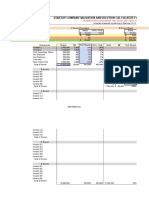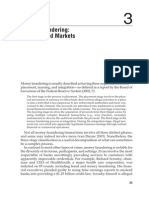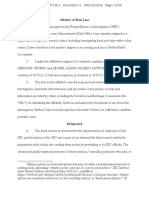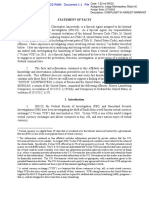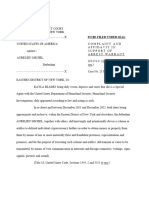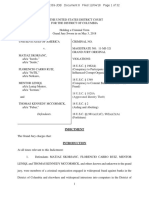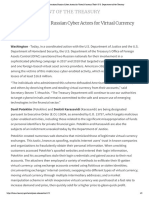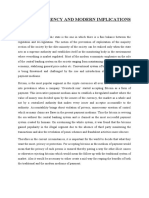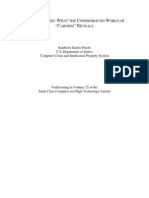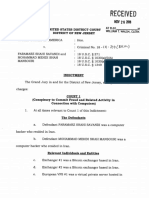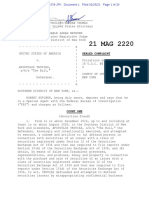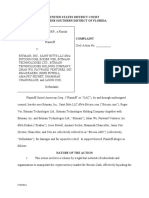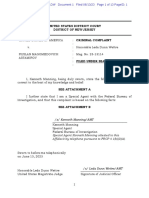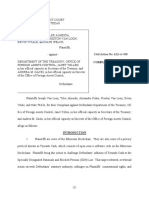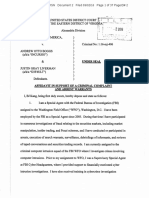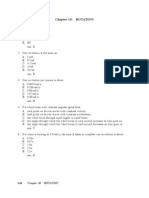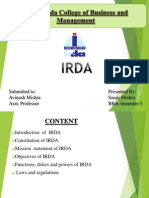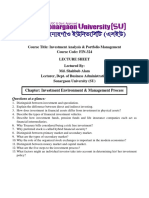Chirag Tomar Coinbase Phishing
Chirag Tomar Coinbase Phishing
Uploaded by
Nguyễn Đức AnhCopyright
Available Formats
Share this document
Did you find this document useful?
Is this content inappropriate?
Report this DocumentCopyright:
Available Formats
Chirag Tomar Coinbase Phishing
Chirag Tomar Coinbase Phishing
Uploaded by
Nguyễn Đức AnhCopyright:
Available Formats
IN THE UNITED STATES DISTRICT COURT
FOR THE WESTERN DISTRICT OF NORTH CAROLINA
CHARLOTTE DIVISION
IN RE APPLICATION OF THE UNITED )
STATES OF AMERICA FOR A CRIMINAL )) CASE NO. 3:23-mj-00453-WCM
COMPLAINT AND AN ARREST )
WARRANT FOR CHIRAG TOMAR )
) UNDER SEAL
)
)
AFFIDAVIT IN SUPPORT OF
APPLICATION FOR ARREST WARRANT
I, Michael S. Hackney, a Special Agent with the United States Secret Service, being duly sworn,
depose and say:
1. I am a Special Agent with the United States Secret Service (“USSS”) and have been so
duly employed as a Special Agent since May 2011. I have received specialized training
and have experience in conducting investigations involving violations of federal law, to
include Wire Fraud, Bank Fraud, Conspiracy and Money Laundering. I am currently
assigned to USSS Charlotte Field Office Cyber Fraud Task Force (“CFTF”) as the Crypto
Currency Group Leader. I have previously completed extensive training at both the Federal
Law Enforcement Training Center, Glynco, GA and the USSS training facility Beltsville,
MD. During my time with the USSS, I have completed over 200 hours of training in cyber
and computer-related investigations and have completed an additional 50 hours of training
specific to cryptocurrency and cryptocurrency investigations to include Crypto Orientation
for Law Enforcement, Crypto Fundamentals Certification, Crypto Certified Investigator,
Case 3:23-mj-00453-WCM Document 3-1 Filed 12/20/23 Page 1 of 17
and the Advanced Crypto Investigator Training Courses. Prior to my employment with the
USSS, I was a Virginia State Police Trooper for six years.
2. This Affidavit is intended to show only that there is sufficient probable cause for the
requested Warrant and does not set forth all my knowledge about this matter.
3. The information contained herein comes from my personal knowledge, information
conveyed by other law enforcement officers, victims identified herein, and publicly
available information.
4. Your Affiant submits that there is probable cause to believe that from on or about August
22, 2020 and continuing through present, in the Western District of North Carolina and
elsewhere, Defendant CHIRAG TOMAR (“TOMAR”), a citizen of the Republic of India,
committed the following offenses: Wire Fraud Conspiracy, in violation of 18 U.S.C. §
1349; and Money Laundering Conspiracy, in violation of 18 U.S.C. § 1956(h).
INTRODUCTION
5. The USSS and the Federal Bureau of Investigation (“FBI”) have been investigating a
cryptocurrency theft and money laundering scheme which involved subjects gaining
unlawful access to the victims’ cryptocurrency exchange accounts and using that access to
conduct unauthorized transfers of cryptocurrency to cryptocurrency exchange accounts
located abroad which were controlled by the fraudsters or their coconspirators.
6. Beginning as late as August 22, 2020, TOMAR and known and unknown coconspirators
conducted the cryptocurrency scheme by using a website designed to resemble the
cryptocurrency exchange Coinbase to trick Coinbase users into providing their log-in
credentials to the fraudsters. The fraudsters then used the victims’ log-in credentials to
access the victims’ Coinbase accounts and transfer the account holdings out of the
Case 3:23-mj-00453-WCM Document 3-1 Filed 12/20/23 Page 2 of 17
accounts. Investigators have identified at least 542 victims of this scheme, including
VICTIM MB 1 of Franklin, Tennessee; VICTIM MF 2 of Charlotte, North Carolina;
VICTIM PC 3 of Mooresville, North Carolina; and VICTIM PAC 4 of West Palm Beach,
Florida. After the cryptocurrency funds were transferred out of the victims’ Coinbase
accounts, the coconspirators, including TOMAR, employed numerous money laundering
techniques with the stolen funds, including: (1) receiving the funds in accounts set up with
fictitious or stolen identities; (2) rapidly moving the stolen funds in various amounts
including commingling with other funds; (3) layering the transactions through multiple
accounts at various exchanges, and (4) converting the funds to other forms of
cryptocurrency, a practice known as “chain hopping,” among other techniques.
DEFINITIONS
7. Cryptocurrency: Cryptocurrency, a type of virtual currency, is a decentralized, peer-to-
peer, network-based medium of value or exchange that may be used as a substitute for fiat1
currency to buy goods or services or exchanged for fiat currency or other cryptocurrencies.
Examples of cryptocurrency are Bitcoin (“BTC”), Ethereum (“ETH”) and Tether
(“USDT”). Cryptocurrency can exist digitally on the Internet, in an electronic storage
device, or in cloud-based servers. Cryptocurrency can be exchanged directly person to
person, through a cryptocurrency exchange, or through other intermediaries. Generally,
cryptocurrency is not issued by any government, bank, or company; it is instead generated
and controlled through computer software operating on a decentralized peer-to-peer
network. Most cryptocurrencies have a “blockchain,” which is a distributed public ledger,
run by the decentralized network, containing an immutable and historical record of every
1 Fiat currency is currency issued and regulated by a government such as the U.S. dollar, euro, or
Japanese yen.
Case 3:23-mj-00453-WCM Document 3-1 Filed 12/20/23 Page 3 of 17
transaction.2 Cryptocurrencies are sent to and received from “addresses.” A
cryptocurrency address is somewhat analogous to a bank account number and is
represented as a 26-to-35-character-long case-sensitive string of letters and numbers. Each
address is controlled through the use of a unique corresponding private key.
8. Virtual Currency Exchanges: Cryptocurrency “exchanges” or “VCEs” are businesses that
allow customers to buy, sell, or trade virtual currency. Many VCEs also store currency on
behalf of their customers. VCEs doing business in the United States are regulated by the
U.S. Department of Treasury and are required to establish anti-money laundering (“AML”)
programs—that is, controls designed to detect and deter money laundering.
9. Coinbase, Binance, MEXC are exchanges: online platforms for buying, selling,
transferring, and storing cryptocurrency. Coinbase is headquartered in San Francisco,
California. Binance is located in the Cayman Islands. MEXC is a Chinese owned company
headquartered in Singapore.
10. Wallet: Cryptocurrency is stored in a virtual account called a wallet. Wallets are software
programs that interface with blockchains and generate and/or store public and private keys
used to send and receive cryptocurrency. A public key or address is akin to a bank account
number, and a private key is akin to a PIN number or password that allows a user the ability
to access and transfer value associated with the public address or key.
2 Some cryptocurrencies operate on blockchains that are not public and operate in such a way to obfuscate
transactions, making it difficult to trace or attribute transactions.
Case 3:23-mj-00453-WCM Document 3-1 Filed 12/20/23 Page 4 of 17
DEFENDANT IDENTIFICATION
11. CHIRAG TOMAR is a thirty-year-old male citizen of the Republic of India. Based on the
evidence contained herein, I believe that Defendant, CHIRAG TOMAR, is the account
owner for an email account used in this scheme (the “TOMAR EMAIL ACCOUNT”).
First, the TOMAR EMAIL ACCOUNT username begins with “chirag.tomar.” Further,
the TOMAR EMAIL ACCOUNT contained multiple photos of a Republic of India
identification card and a Republic of India Passport belonging to CHIRAG TOMAR. The
TOMAR EMAIL ACCOUNT emailed these photos on several occasions, including to
apply for a travel visa to the United States for TOMAR. Additionally, within the records
of the TOMAR EMAIL ACCOUNT, investigators identified emails from ICICI Bank
with statements in the name of Chirag Tomar and emails with TOMAR’s personal
information used to book hotels and receive food deliveries, among other personal
activities.
12. Investigators confirmed that TOMAR was granted a travel visa to the United States and
have compared the visa photo to that contained in the TOMAR EMAIL ACCOUNT, and
determined that it is the same Chirag Tomar. This United States visa application for
TOMAR provided a work telephone number for TOMAR ending in 3999 (the “TOMAR
PHONE”). Further, on April 1, 2022, the TOMAR EMAIL ACCOUNT received an
email containing a booking confirmation for the Holiday Inn New Delhi International
Airport which was in the name of Chirag Tomar and provided the TOMAR PHONE as
TOMAR’s contact number. Finally, the TOMAR EMAIL ACCOUNT received a bill on
March 31, 2022 for a mobile phone account in TOMAR’s name which was for the
TOMAR PHONE.
Case 3:23-mj-00453-WCM Document 3-1 Filed 12/20/23 Page 5 of 17
13. A MEXC exchange account ending in 7727 (the “TOMAR MEXC ACCOUNT”)
identified pursuant to this investigation, was registered as having the TOMAR PHONE
as the account phone number. However, although this account was linked to the TOMAR
PHONE, it was registered under a different name. Investigators believe TOMAR to be
the true account holder. Investigators believe that TOMAR’s use of a fictitious name for
the TOMAR MEXC ACCOUNT is indicative of an attempt to conceal the true identity
of the account holder and obfuscate the nature and source of the cryptocurrency
transactions that took place therein.
14. A review of TOMAR EMAIL ACCOUNT Google search history shows searches
between June 29, 2021 and October 26, 2022 associated with the cryptocurrency fraud
scheme described herein. Those searches by TOMAR included: “Fake coinbase page,”
“Coinbase scam,” “How to take money from coinbase without OTP,3” “need coinbase
traffic,” “Scams in the USA,” and others. The review indicates there were more than 25
such searches in the above time frame.
PROBABLE CAUSE
15. At the times set forth herein, Coinbase, the publicly traded exchange that serves legitimate
purposes, maintained a legitimate website at https://pro.coinbase.com. Coinbase Pro was
an advanced trading platform advertised for Coinbase customers who frequently trade
cryptocurrency. According to the Coinbase Pro website, users of cryptocurrency (users
such as the victims identified herein), would access Coinbase Pro and Coinbase services to
buy, sell, and manage cryptocurrency.
3
OTP is a One Time Passcode, which sends a code to a device of your choosing to authenticate that the true owner
is seeking to access the account. This search indicates that TOMAR was seeking to gain unauthorized access to
Coinbase accounts without having to acquire the OTP two-factor authentication.
Case 3:23-mj-00453-WCM Document 3-1 Filed 12/20/23 Page 6 of 17
16. Investigators identified a family of websites that were designed to mimic or “spoof” the
legitimate Coinbase Pro website in order to “phish” for victims’ log-in credentials. These
lookalike websites could be found at URLs that featured variations of “coinbasepro.com”
or were the landing pages from redirections from such sites, including the following:
“coinbasepro.com,” “fastsupport.gotoassist.com,” “autho.coinbasepro.com,”
“primetoyking.com,” and “coimdrazeprogogicsecure.com” (collectively, the “CBP
Phishing Sites”). Fraudsters commonly create phishing websites, that is, websites designed
by fraudsters to mimic the appearance of legitimate websites, to falsely gain the trust of
users, and fraudulently obtain users’ personal and private information, including sensitive
account information. In this case, the CBP Phishing Sites appear to have been designed to
capture Coinbase users’ log-in credentials. Based on the similar URLs and website design,
victims who were searching for the legitimate Coinbase Pro website were tricked into
accessing the CBP Phishing Sites.
Case 3:23-mj-00453-WCM Document 3-1 Filed 12/20/23 Page 7 of 17
17. At all relevant times, pro.coinbase.com was a legitimate URL to route to the true Coinbase
Pro website. However, the URL coinbasepro.com would redirect victims to the CBP
Phishing Sites. At all relevant times, the CBP Phishing Sites consisted of a well-
constructed webpage purporting to be the legitimate Coinbase cryptocurrency exchange,
featuring high-quality graphics and a login screen that prompted the user to provide their
Coinbase username and password, consistent with the real Coinbase site. The following is
an image depicting the CBP Phishing Sites:
18. Most icons and links featured on the CBP Phishing Sites were inoperable. The CBP
Phishing Sites were essentially a single page without functioning links. Some links would
only display an “account is disabled”-type pop up screen regardless of the context of the
Case 3:23-mj-00453-WCM Document 3-1 Filed 12/20/23 Page 8 of 17
link. The CBP Phishing Sites also featured several instances of improper terminology and
grammatical errors, such as words lacking proper capitalization or structure. This is a
possible indication that the creators are not native English speakers and/or are based outside
the country and is certainly not indicative of a website operated by an organized publicly
traded company such as the legitimate Coinbase.
19. The CBP Phishing Sites were designed to trick each victim into changing his or her
password by initiating a series of steps described herein. When a victim would accidentally
visit the CBP Phishing Sites and attempt to login with their valid Coinbase credentials, the
victim would be notified that their account was locked and prompted to call a phone
number that was provided in a chat window to speak to a purported Coinbase
representative. The phone number connected the victims to a coconspirator who purported
to be an employee of Coinbase. At this point in the fraud scheme, a real password-reset
link would then be sent to the victim and the fraudulent Coinbase representative would
request that the victim provide the real password-reset link in the chat. The provided link
by the victim was a legitimate link from Coinbase allowing the actor to change the victim’s
account password. By tricking the victim into providing the password reset link, the actor
was then able to use the link to change the victim’s Coinbase password and gain control of
the victim’s Coinbase account. The fraudsters then used their control over the Coinbase
accounts to transfer funds to accounts they controlled. Investigators accessed the CBP
Phishing Sites and observed the above-described steps of the fraud scheme. Investigators
further determined that no matter what login information was entered on the CBP Phishing
Sites, the website always indicated that a user’s account was disabled or locked.
Case 3:23-mj-00453-WCM Document 3-1 Filed 12/20/23 Page 9 of 17
20. Investigators have determined using open-source domain registration website,
www.whois.com, that the fraudulent website Coinbasepro.com was first registered on
August 22, 2020.
VICTIM MB 1
21. On September 25, 2021, while attempting to access his Coinbase account online, VICTIM
MB 1 was unable to log in. VICTIM MB 1 then attempted to change his password, and
VICTIM MB 1 utilized the live chat feature on (what VICTIM MB 1 believe to be) the
Coinbase website to do so. The support employee advised VICTIM MB 1 that he would
receive a phone call to execute the password change. VICTIM MB 1 then had an incoming
call and the other party verified VICTIM MB 1’s identity. The caller, purportedly a
representative from Coinbase, then instructed VICTIM MB 1 to provide an emailed link
from Coinbase in the chat window. Based on my knowledge of the investigation and
experience with Coinbase, I believe that VICTIM MB 1 had accidentally directed their
browser to coinbasepro.com, the CBP Phishing Site. Accordingly, shortly after providing
the link in the chat window, VICTIM MB 1 noticed an unauthorized transfer of
approximately 63.11323345 Ethereum (“ETH”) and 0.8 Bitcoin (“BTC”) out of their
Coinbase account to an external account, worth approximately $170,955.
22. Coinbase records of VICTIM MB 1’s account reflect that on September 25, 2021, the
transfer of approximately 63.11323345 ETH and 0.8 BTC occurred to an account at
Binance from the victim’s Coinbase account.
23. Records reflect that the Binance account that received VICTIM MB 1’s stolen funds was
in the name of an individual, R.A., and registered with an email account, EMAIL
ACCOUNT 1.
10
Case 3:23-mj-00453-WCM Document 3-1 Filed 12/20/23 Page 10 of 17
24. Email records acquired by investigators pursuant to search warrants reflected that on
August 11, 2021, the TOMAR EMAIL ACCOUNT sent two emails to EMAIL
ACCOUNT 1. The first email had an attached photo of the identification card of R.A.
from the Election Commission of India. The second email had a photo of R.A’s Indian
passport. I believe based on my experience and the order of events, these identification
documents appear to be stolen or fraudulently obtained. Approximately ten minutes after
receiving the identification document photos, EMAIL ACCOUNT 1 received two emails
from Binance confirming identity verification for the account opening of the Binance
account which received the victim funds. Based on the above, it appears that TOMAR
provided stolen or fraudulently obtained identification documents of R.A. to EMAIL
ACCOUNT 1 for the purposes of opening an Binance account in R.A.’s name to receive
cryptocurrency stolen from VICTIM MB 1. On September 25, 2021, the day of the
unauthorized transfer of BTC and ETH from VICTIM MB 1’s Coinbase account, Binance
sent emails to EMAIL ACCOUNT 1 confirming the stolen 63 ETH and 0.8 BTC fund
deposits into that Binance account.
25. In an email sent on January 24, 2022, another email account, EMAIL ACCOUNT 2, sent
the TOMAR EMAIL ACCOUNT a .txt file with the filename of notepad 2.txt. VICTIM
MB 1’s phone number, name, and amount of funds stolen was located in this file, alongside
the date of September 25, 2021. This coincides with the fraudulent transaction from
VICTIM MB 1’s Coinbase account.
VICTIM MF 2
26. On January 26, 2022, VICTIM MF 2 attempted to login to his Coinbase account using his
internet browser. VICTIM MF 2 was unknowingly redirected to a site that looked exactly
11
Case 3:23-mj-00453-WCM Document 3-1 Filed 12/20/23 Page 11 of 17
like Coinbase, and I believe based on the knowledge of this investigation that he had
accidentally directed his browser to the CBP Phishing Sites. VICTIM MF 2 attempted to
log in with his account credentials, but the website said his account had been locked and to
call customer support to access his account. VICTIM MF 2 spoke on the phone with a
purported Coinbase customer support representative. Similar to the scheme perpetrated on
VICTIM MB 1, VICTIM MF 2 provided a link to the impostor Coinbase representative,
which resulted in VICTIM MF 2’s Coinbase account being compromised. Shortly
thereafter, an unauthorized transfer of .3396 BTC was executed from VICTIM MF 2’s
Coinbase account to an external account.
27. In an email sent on February 16, 2022, another email account, EMAIL ACCOUNT 3, sent
the TOMAR EMAIL ACCOUNT a .txt file with the filename of New Text Document.txt.
Victim MF 2’s phone number, name, and amount of funds stolen was located in this file,
alongside the date January 26, 2022. This coincides with the fraudulent transactions from
VICTIM MF 2’s Coinbase account.
VICTIM PC 3
28. On April 16, 2022, VICTIM PC 3 attempted to access his Coinbase account using his
internet browser. VICTIM PC 3 was unknowingly redirected to a site that looked exactly
like Coinbase, and I believe based on the knowledge of this investigation that he had
accidentally directed his browser to the CBP Phishing Sites. VICTIM PC 3 attempted to
log in with his account credentials and the website refreshed with a new screen that
indicated that VICTIM PC 3’s account was locked and to call a number or communicate
with Coinbase customer service via a pop-up screen. A purported Coinbase customer
service representative convinced VICTIM PC 3 to provide access to his account to the
12
Case 3:23-mj-00453-WCM Document 3-1 Filed 12/20/23 Page 12 of 17
representative. After VICTIM PC 3 provided his two-factor authorization password, he
was told that his account was unlocked and to access it. VICTIM PC 3 accessed his account
and saw his expected balance of $132,515.51 in U.S. Currency in his account for a few
moments. At this time, VICTIM PC 3 received emails that transactions were taking place
in his Coinbase account without the authorization of VICTIM PC 3. VICTIM PC 3 then
observed that his balance of $132,515.51 was converted to 44.09 ETH in his Coinbase
account and also received a notification that there was an attempt to exchange the ETH for
USDT, but that the exchange was cancelled. On April 16, 2022, the 44.09 ETH was
transferred out of VICTIM PC 3’s Coinbase wallet to multiple cryptocurrency addresses
before being sent to the TOMAR MEXC ACCOUNT without VICTIM PC 3’s
authorization. Furthermore, it was determined that 8.81 ETH was transferred from two
other victims and consolidated into VICTIM PC 3’s transfer, for a total of 52.90 ETH.
29. VICTIM PC 3’s funds were converted from fiat currency to ETH by the fraudsters and sent
to the TOMAR MEXC ACCOUNT on April 16, 2022. The next day, April 17, 2022,
TOMAR, via the TOMAR MEXC ACCOUNT, executed a “chain hop” of the funds by
converting the stolen funds from 52.9 ETH to 164,626.58 USDT and transferred the funds
out of his account to an address ending in G91RL, a decentralized address,4 before being
4
A decentralized address is an address on the blockchain that does not belong to an exchange or other avenue that
identifies the true owner. This address is able to facilitate transfers to other addresses with the appropriate public
and private keys.
13
Case 3:23-mj-00453-WCM Document 3-1 Filed 12/20/23 Page 13 of 17
sent to the Binance account of another individual. The below graph depicts the assets being
stolen and moved through the block chain:
VICTIM PAC 4
30. On June 6, 2022, VICTIM PAC 4 sought to access his Coinbase account but accidentally
entered coinbasepro.com into his web browser, which guided him to the CBP Phishing
Sites. VICTIM PAC 4 entered his username and password, which initiated a banner along
the top of the webpage, which indicated that there was a security issue and instructed him
to call the displayed Coinbase customer service phone number. VICTIM PAC 4 called the
number provided and a purported Coinbase representative answered that he could help
VICTIM PAC 4 execute an account reset over the phone. VICTIM PAC 4 was instructed
14
Case 3:23-mj-00453-WCM Document 3-1 Filed 12/20/23 Page 14 of 17
to click the chat icon on the bottom right corner of his screen. Later in the chat, VICTIM
PAC 4 was asked to provide the impostor Coinbase representative with authentication
codes that had been sent to his phone. VICTIM PAC 4 provided the codes. VICTIM PAC
4 also uploaded copies of his Driver’s License to the web chat, as instructed by individual.
Later, after checking his account, VICTIM PAC 4 observed that the fraudsters had accessed
his Coinbase account and converted his cryptocurrency to 138.5 ETH, and then, after
bypassing account verification with his own submitted ID, transferred the ETH out of his
Coinbase account. On or about June 6, 2022, the 138.5 ETH was subsequently transferred
out of VICTIM PAC 4’s Coinbase wallet to multiple decentralized cryptocurrency wallets.
On or about June 7, 2022, the 138.5 ETH of VICTIM PAC 4’s stolen funds were
commingled with other victim funds, totaling 161.36 ETH. The 161.36 ETH were
converted to 325,152 USDT in a decentralized address ending in 02d1b.
31. On or about June 8, 2022, 200,000 USDT of the victim funds were sent to the TOMAR
MEXC ACCOUNT. On or about June 9, 2022, TOMAR executed a “chain hop” with the
victim funds, by switching the 200,000 USDT from its Ethereum block chain to another
blockchain known as the TRX network and transferred the funds out of the account.
CONCLUSION
32. Investigators have determined that VICTIM MB 1, VICTIM MF 2, VICTIM PC 3 and
VICTIM PAC 4 were victims of the same fraud conspiracy. An analysis of the victim
spreadsheets located in the TOMAR EMAIL ACCOUNT sent between CHIRAG
TOMAR and known and unknown coconspirators revealed phone numbers, names, and
amount of funds stolen of approximately 542 victims between July 1, 2021 to February 24,
2022. The records reflect a total victim loss of $19.9 million USD.
15
Case 3:23-mj-00453-WCM Document 3-1 Filed 12/20/23 Page 15 of 17
33. An analysis of the TOMAR MEXC ACCOUNT revealed frequent money laundering
activity committed by TOMAR through this account. The account shows deposits, among
other cryptocurrencies, of 4,401,727 USDT and 66.83 BTC and frequent “chain hop”
conversions and rapid transfers of cryptocurrencies out of the account.
34. Based on the foregoing, your Affiant submits that there is probable cause to believe that
CHIRAG TOMAR violated 18 U.S.C. § 1956(h), which makes it a crime in relevant part
to conspire to transmit or transfer funds from a place in the United States to a place outside
the United States knowing that the funds involved in the transmission or transfer
represented the proceeds of some form of specified unlawful activity and knowing that
such transmission or transfer is designed in whole or in part to conceal or disguise the
nature, location, source, ownership, or control of the proceeds of the specified unlawful
activity. For the purposes of this section, specified unlawful activity includes wire fraud,
in violation of 18 U.S.C. § 1343.
35. Your Affiant submits there is also probable cause to believe that CHIRAG TOMAR
violated 18 U.S.C. § 1349, which makes it a crime in relevant part to conspire to commit
wire fraud, 18 U.S.C. § 1343, which is obtaining money or property by means of false or
fraudulent pretenses through the use of interstate or foreign commerce.
/S/_Michael S. Hackney
Michael S. Hackney
Special Agent
United States Secret Service
Western District of North Carolina
Affidavit Reviewed by Assistant United States Attorney Matthew T. Warren
16
Case 3:23-mj-00453-WCM Document 3-1 Filed 12/20/23 Page 16 of 17
In accordance with Rule 4.1(b)(2)(A), the Affiant attested under oath to the contents of this
Affidavit, which was submitted to me by reliable electronic means, on this 20th day of December
2023, at 8:34 AM.
Signed: December 20, 2023
17
Case 3:23-mj-00453-WCM Document 3-1 Filed 12/20/23 Page 17 of 17
You might also like
- 138 Legal Notice FormatDocument2 pages138 Legal Notice Formatarunbnsal350776% (21)
- Cryptocurrency: Beginners Bible - How You Can Make Money Trading and Investing in CryptocurrencyFrom EverandCryptocurrency: Beginners Bible - How You Can Make Money Trading and Investing in CryptocurrencyRating: 4 out of 5 stars4/5 (73)
- Valuation and Dilution CalculatorDocument14 pagesValuation and Dilution CalculatorNguyễn Đức AnhNoch keine Bewertungen
- 1 23 MJ 67 Affidavit JFADocument31 pages1 23 MJ 67 Affidavit JFAmichaelkan1Noch keine Bewertungen
- Push Back - TrainingDocument20 pagesPush Back - TrainingNicolas PrietoNoch keine Bewertungen
- Cybercrime and the Darknet: Revealing the hidden underworld of the internetFrom EverandCybercrime and the Darknet: Revealing the hidden underworld of the internetRating: 5 out of 5 stars5/5 (1)
- Filed Stamped Copy - Complaint 20cv2396 0Document30 pagesFiled Stamped Copy - Complaint 20cv2396 0MichaelPatrickMcSweeneyNoch keine Bewertungen
- PhishingDocument12 pagesPhishingaurox3dNoch keine Bewertungen
- Cyber Money Laundering PDFDocument19 pagesCyber Money Laundering PDFjatin sanehiNoch keine Bewertungen
- Concept Paper in IctDocument11 pagesConcept Paper in IctNicole Ashley Cruz85% (27)
- DeMarr ComplaintDocument18 pagesDeMarr ComplaintJ RohrlichNoch keine Bewertungen
- RICHO Phising ComplaintDocument15 pagesRICHO Phising ComplaintDeepDotWeb.comNoch keine Bewertungen
- Money Laundering: Methods and MarketsDocument0 pagesMoney Laundering: Methods and MarketsThilaga SenthilmuruganNoch keine Bewertungen
- USA v. Cedeno Et Al Doc 3-1Document24 pagesUSA v. Cedeno Et Al Doc 3-1scion.scionNoch keine Bewertungen
- Crisafi Federal ComplaintDocument9 pagesCrisafi Federal ComplaintHamptonSalemNHPatchNoch keine Bewertungen
- Robert Novy Deputy Assistant Director Office of Investigations United States Secret Service Prepared Testimony Before the United States House of Representatives Committee on Financial Services Subcommittee on Terrorism and Illicit FinanceDocument7 pagesRobert Novy Deputy Assistant Director Office of Investigations United States Secret Service Prepared Testimony Before the United States House of Representatives Committee on Financial Services Subcommittee on Terrorism and Illicit FinanceCrowdfundInsiderNoch keine Bewertungen
- Michael Richo Criminal ComplaintDocument16 pagesMichael Richo Criminal ComplaintSoftpedia100% (1)
- Lichtenstein and Morgan - Statement of FactsDocument20 pagesLichtenstein and Morgan - Statement of FactsMatt Troutman100% (1)
- Virtual Currency HearingsDocument17 pagesVirtual Currency HearingsReid DouthatNoch keine Bewertungen
- Virtual Currency Response LettersFederal Agencies Respond To Homeland Security Committee Questions On Digital CurrenciesDocument17 pagesVirtual Currency Response LettersFederal Agencies Respond To Homeland Security Committee Questions On Digital CurrenciesWiredEnterprise100% (2)
- Statement of Facts - USA Vs Ilya Lichtenstein & Heather Rhiannon MorganDocument20 pagesStatement of Facts - USA Vs Ilya Lichtenstein & Heather Rhiannon MorganhyenadogNoch keine Bewertungen
- NFT Developer Charged in Multi-Million Dollar International Fraud SchemeDocument16 pagesNFT Developer Charged in Multi-Million Dollar International Fraud SchemeKevin MacdonaldNoch keine Bewertungen
- 3D16 1860Document33 pages3D16 1860Anonymous bwDR71CtNoch keine Bewertungen
- Darkode 2019 ChargesDocument32 pagesDarkode 2019 ChargesCatalin Cimpanu [ZDNet]Noch keine Bewertungen
- Defendants.: 18 U.S.C. 1028A (Aggravated Identity Theft)Document32 pagesDefendants.: 18 U.S.C. 1028A (Aggravated Identity Theft)part11Noch keine Bewertungen
- Lichtenstein Morgan Press ReleaseDocument3 pagesLichtenstein Morgan Press ReleaseABC News PoliticsNoch keine Bewertungen
- Joseph Kim Federal Criminal Complaint, AffidavitDocument16 pagesJoseph Kim Federal Criminal Complaint, AffidavitJonah MeadowsNoch keine Bewertungen
- Bowen V. LiDocument16 pagesBowen V. LiKyla TerblancheNoch keine Bewertungen
- Cryptocurrency-Fincen and Discovery of Hidden WealthDocument5 pagesCryptocurrency-Fincen and Discovery of Hidden Wealthcadizza23Noch keine Bewertungen
- Mosley Cracking Cards ComplaintDocument16 pagesMosley Cracking Cards ComplaintSteve WarmbirNoch keine Bewertungen
- SSRN Id2393537Document108 pagesSSRN Id2393537Ana Luisa EisenlohrNoch keine Bewertungen
- Treasury Sanctions Russian Cyber Actors For Virtual Currency Theft - U.S. Department of The TreasuryDocument3 pagesTreasury Sanctions Russian Cyber Actors For Virtual Currency Theft - U.S. Department of The TreasuryViviane BocalonNoch keine Bewertungen
- Cryptocurrency and Modern ImplicationsDocument6 pagesCryptocurrency and Modern ImplicationsKaran VyasNoch keine Bewertungen
- FBI Complaint Against Steven Nerayoff and Michael HladyDocument12 pagesFBI Complaint Against Steven Nerayoff and Michael HladyJamesNoch keine Bewertungen
- D B: W U W "C " R: ATA Reaches Hat The Nderground Orld of Arding EvealsDocument33 pagesD B: W U W "C " R: ATA Reaches Hat The Nderground Orld of Arding EvealsMalik Tanveer HussainNoch keine Bewertungen
- Fixing Flores: Assuring Adequate Penalties For Identity Theft and FraudDocument20 pagesFixing Flores: Assuring Adequate Penalties For Identity Theft and FraudCenter for Immigratoin StudiesNoch keine Bewertungen
- UntitledDocument25 pagesUntitledsaharaReporters headlinesNoch keine Bewertungen
- Savandi and Mansouri Indictment 11.26.18!2!0Document26 pagesSavandi and Mansouri Indictment 11.26.18!2!0jonathan_skillingsNoch keine Bewertungen
- TROVIAS IndictmentDocument20 pagesTROVIAS Indictmentmichaelkan1Noch keine Bewertungen
- Coalition Complaint Against The Fbi - Sec - DojDocument11 pagesCoalition Complaint Against The Fbi - Sec - DojdeathdlrNoch keine Bewertungen
- Bcash SuitDocument57 pagesBcash SuitAnonymous BLkOv8hKNoch keine Bewertungen
- Computer Crimes ProsecutionDocument8 pagesComputer Crimes ProsecutionJosephine MutuoNoch keine Bewertungen
- UTS 2020 Ekonomika Internasional IIDocument3 pagesUTS 2020 Ekonomika Internasional IIMayang PertiwiNoch keine Bewertungen
- Summary of Kevin Sullivan's Anti-Money Laundering in a NutshellFrom EverandSummary of Kevin Sullivan's Anti-Money Laundering in a NutshellNoch keine Bewertungen
- Bitmain LawsuitDocument57 pagesBitmain LawsuitCCNNoch keine Bewertungen
- USA V Ruslan Magomedovich AstamirovDocument13 pagesUSA V Ruslan Magomedovich AstamirovFile 411Noch keine Bewertungen
- FINAL - Tornado Cash ComplaintDocument20 pagesFINAL - Tornado Cash Complaintjeff_roberts881Noch keine Bewertungen
- Bagus Jatmiko Crypto Investigation Report For ExchangesDocument14 pagesBagus Jatmiko Crypto Investigation Report For ExchangesTIMMY BOYNoch keine Bewertungen
- Money LaunderingDocument7 pagesMoney LaunderingViorel NicaNoch keine Bewertungen
- Cryptocurrency: The New Face of Cyber Money Laundering: Sagwadi MabundaDocument6 pagesCryptocurrency: The New Face of Cyber Money Laundering: Sagwadi MabundaYimy GarciaNoch keine Bewertungen
- 1:16 MJ 00406Document37 pages1:16 MJ 00406IDG News ServiceNoch keine Bewertungen
- Cryptocurrency Money Laundering Methods Free GuideDocument16 pagesCryptocurrency Money Laundering Methods Free GuideKarima AmiraNoch keine Bewertungen
- An Event Study of The Effects of Cryptocurrency Thefts OnDocument12 pagesAn Event Study of The Effects of Cryptocurrency Thefts OnSUGI YANTONoch keine Bewertungen
- 3 Iis 2022 242-252Document11 pages3 Iis 2022 242-252mothewockstarNoch keine Bewertungen
- United States v. Alfred Monostra, III, 125 F.3d 183, 3rd Cir. (1997)Document12 pagesUnited States v. Alfred Monostra, III, 125 F.3d 183, 3rd Cir. (1997)Scribd Government DocsNoch keine Bewertungen
- Fincen Advisory CVC Final 508 - 0Document12 pagesFincen Advisory CVC Final 508 - 0Crypto Insider100% (1)
- TJX Amended Consolidated Class Action ComplaintDocument46 pagesTJX Amended Consolidated Class Action ComplaintgesmerNoch keine Bewertungen
- USA V Lichtenstein Felony InformationDocument12 pagesUSA V Lichtenstein Felony InformationFile 411Noch keine Bewertungen
- The Dark Side of Digital Gold: Unmasking Cryptocurrency ScamsFrom EverandThe Dark Side of Digital Gold: Unmasking Cryptocurrency ScamsNoch keine Bewertungen
- Bowen ComplaintDocument49 pagesBowen Complaintthe kingfishNoch keine Bewertungen
- (Re)Thinking Crypto: The Crash of FTX and the Rise of Safer, Stronger Digital AssetsFrom Everand(Re)Thinking Crypto: The Crash of FTX and the Rise of Safer, Stronger Digital AssetsNoch keine Bewertungen
- An Introduction To Cryptocurrency Laws In The United States: A Simplified And Concise GuideFrom EverandAn Introduction To Cryptocurrency Laws In The United States: A Simplified And Concise GuideNoch keine Bewertungen
- Cryptonomicon: From Enigma to Blockchain: Exploring the Rise of Modern Cryptography, World War II Codebreaking, and the Advent of Blockchain Technology: Cryptonomicon: Unveiling the Roots of Digital Currency, #2From EverandCryptonomicon: From Enigma to Blockchain: Exploring the Rise of Modern Cryptography, World War II Codebreaking, and the Advent of Blockchain Technology: Cryptonomicon: Unveiling the Roots of Digital Currency, #2Noch keine Bewertungen
- Hacking the System: Using Crypto to Protect Your Privacy and MoneyFrom EverandHacking the System: Using Crypto to Protect Your Privacy and MoneyNoch keine Bewertungen
- Ooyala State of The Broadcast Industry 2018Document14 pagesOoyala State of The Broadcast Industry 2018Nguyễn Đức AnhNoch keine Bewertungen
- Bitmovin PlayerDocument6 pagesBitmovin PlayerNguyễn Đức AnhNoch keine Bewertungen
- Neuner ConsumerProfiling PDFDocument5 pagesNeuner ConsumerProfiling PDFNguyễn Đức AnhNoch keine Bewertungen
- Chapter 6 Corporate-Level Strategy StudentDocument12 pagesChapter 6 Corporate-Level Strategy StudentNguyễn Đức AnhNoch keine Bewertungen
- 44 Test Bank 10Document22 pages44 Test Bank 10Pamela HancockNoch keine Bewertungen
- 2016 066 RC - LuelcoDocument11 pages2016 066 RC - LuelcoJoshua GatumbatoNoch keine Bewertungen
- Insurance Regulatory and Development ActDocument13 pagesInsurance Regulatory and Development ActSai VasudevanNoch keine Bewertungen
- ISN - PERNEFRI ProposalDocument1 pageISN - PERNEFRI ProposalRiandhicapratamaNoch keine Bewertungen
- b0193wq HDocument68 pagesb0193wq HJúlia KistNoch keine Bewertungen
- Ccure-9000-V1 93 SG r01 LT enDocument9 pagesCcure-9000-V1 93 SG r01 LT enzinnerbrNoch keine Bewertungen
- 1 PDFDocument53 pages1 PDFChelle BelenzoNoch keine Bewertungen
- Investment Environment & Management ProcessDocument10 pagesInvestment Environment & Management ProcessMd Shahbub Alam SonyNoch keine Bewertungen
- Doctrine of Rule of LawDocument8 pagesDoctrine of Rule of LawAkshay BhasinNoch keine Bewertungen
- Historical SchoolDocument8 pagesHistorical Schoolalishaneeru2102Noch keine Bewertungen
- A Study On The Financial and Operational Efficiency of Sakthi Finance LimitedDocument88 pagesA Study On The Financial and Operational Efficiency of Sakthi Finance LimitedmaheswariNoch keine Bewertungen
- Commonwealth Literature EngDocument13 pagesCommonwealth Literature EngFurti FizaNoch keine Bewertungen
- Street PhotographyDocument14 pagesStreet PhotographyNicolas ANoch keine Bewertungen
- 134-1 - Motion For Judicial NoticeDocument67 pages134-1 - Motion For Judicial NoticeRipoff ReportNoch keine Bewertungen
- VILGST - SGST - High Court Cases - 2023-VIL-360-CALDocument6 pagesVILGST - SGST - High Court Cases - 2023-VIL-360-CALBhanuprakash GuptaNoch keine Bewertungen
- Annotated BibliographyDocument13 pagesAnnotated BibliographyAgastya VaidyaNoch keine Bewertungen
- Inventory-Forms 2023Document16 pagesInventory-Forms 2023Joselito M. BaborNoch keine Bewertungen
- Buddha or MarxDocument16 pagesBuddha or MarxbhargavNoch keine Bewertungen
- Doa-Doa Nabi: Shallallahu Alaihi Wa SallamDocument28 pagesDoa-Doa Nabi: Shallallahu Alaihi Wa SallamsaptiNoch keine Bewertungen
- Apex Mining Co Inc - Conso AFS As of 12.13.14Document100 pagesApex Mining Co Inc - Conso AFS As of 12.13.14Ashley Ibe GuevarraNoch keine Bewertungen
- Pap Khouma InterviewDocument4 pagesPap Khouma Interviewcycnus13Noch keine Bewertungen
- SECTION 01 51 00 Temporary Facilities and Controls Part 1 - GeneralDocument6 pagesSECTION 01 51 00 Temporary Facilities and Controls Part 1 - GeneralAlexander MasongsongNoch keine Bewertungen
- 027 - AARTO Chargebook July 2008Document111 pages027 - AARTO Chargebook July 2008alfonseoNoch keine Bewertungen
- Charter PartiesDocument2 pagesCharter PartiesShohel AhmedNoch keine Bewertungen
- Criminal Case DraftDocument5 pagesCriminal Case DraftDee WhyNoch keine Bewertungen
- Maureen Teoh V Roselle Mont-Clair FurnishingDocument5 pagesMaureen Teoh V Roselle Mont-Clair FurnishingSerenaNoch keine Bewertungen
- Trade Union Definitions 1. Section 2 Trade Union Act 1959Document47 pagesTrade Union Definitions 1. Section 2 Trade Union Act 1959SandheaNoch keine Bewertungen


